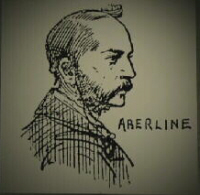Double Event
Whitechapel
Dr Brown's evidence produced a significant shift in the police investigation. Instead of looking for medical man, they now began looking for someone
local, who might know something of human anatomy. Shortly after the body was found, just a few streets away, a policeman made a startling discovery. A
piece of what proved to be Eddowes apron, covered in blood and faeces. Above the apron was a message.
Ripper Graffiti?
Don Rumblelow "One version has it: The Jews are not the men that will be blamed for nothing or the Jews are the men that will not be blamed for nothing"
But, the location of the message and the piece of apron, just a few streets from Mitre Square in the direction of Whitechapel, might also be a vital clue.
The discarded apron suggested that he was heading back home, to his hideout. Geographic profiling that we use of modern murder investigations has him
living within 200 yards of Dorset Street and it suggests that this is his hideout.
What is clear, however, is that the police did not make the best of this information. The two murders took place in different police areas.
Gareth Williams "Catherine Eddowes was murdered on Mitre Square, so she was murdered in the city of London. And, that brought the city of London
police into the investigation."
What caused the disagreement, was the message's inflammatory racial content.
Gareth Williams "That is obviously anti-Semitic graffiti So, the Metropolitan police are remembering now, the leather-apron scare"
Gareth Williams
The police desperately needed a break in the investigation, something to assuage the public fears about the murderer. The following day, they
released two notorious letters allegedly penned by the killer, and signed Jack the Ripper.
Both letters were written in the same hand, and sent within just a few days of each other.
Gareth Williams "As a consequence, the murders are now, almost, turned into a street pantomime. And, five sordid East-End murders became a
national phenomenon and the unknown miscreant for those murders was elevated to the realm of legend."
Police Enquiries
On October 3, the police began a house to house search that took over two weeks to complete. 100,000 handbills were distributed but, as the press
reported, not the slightest clue to the murderer was obtained.
We don't know the kind of man the police were looking for, but in later years, Scotland Yard's man on the ground in Whitechapel, Frederick
Aberline, advanced a theory of his own. Aberline believed the most likely killer was a Pole named Severin Antoniovich Klosowski, who also
called himself George Chapman.

Frederick Aberline
The Chapman theory whilst given an additional credibility by being advanced by no less an authority than Aberline suffers from one fundamental
flaw. Why would Jack the Ripper have suddenly changed from throat-cutting to poisoning. The house-to-house investigation had produced no lasting
suspects, neither did the publication of the famous letters. The police were deluged with hoax communications, one of which stood out.
George Lust, a prominent local businessman, received a small package. It contained a kidney and a note claiming that it had come from Catherine
Eddowes. No one knows if the kidney really came from Eddowes or if the note was from her killer. It was, nevertheless, chilling in the extreme.
Jack the Ripper had everyone on his trail. Including to London police forces and the country's top detectives. His elusiveness was nothing
short of miraculous.
The double-event murders of Elizabeth Stride and Catherine Eddowes horrified the public and press alike, but October would pass without a
murder and a slight sense of normality returned to Whitechapel.
